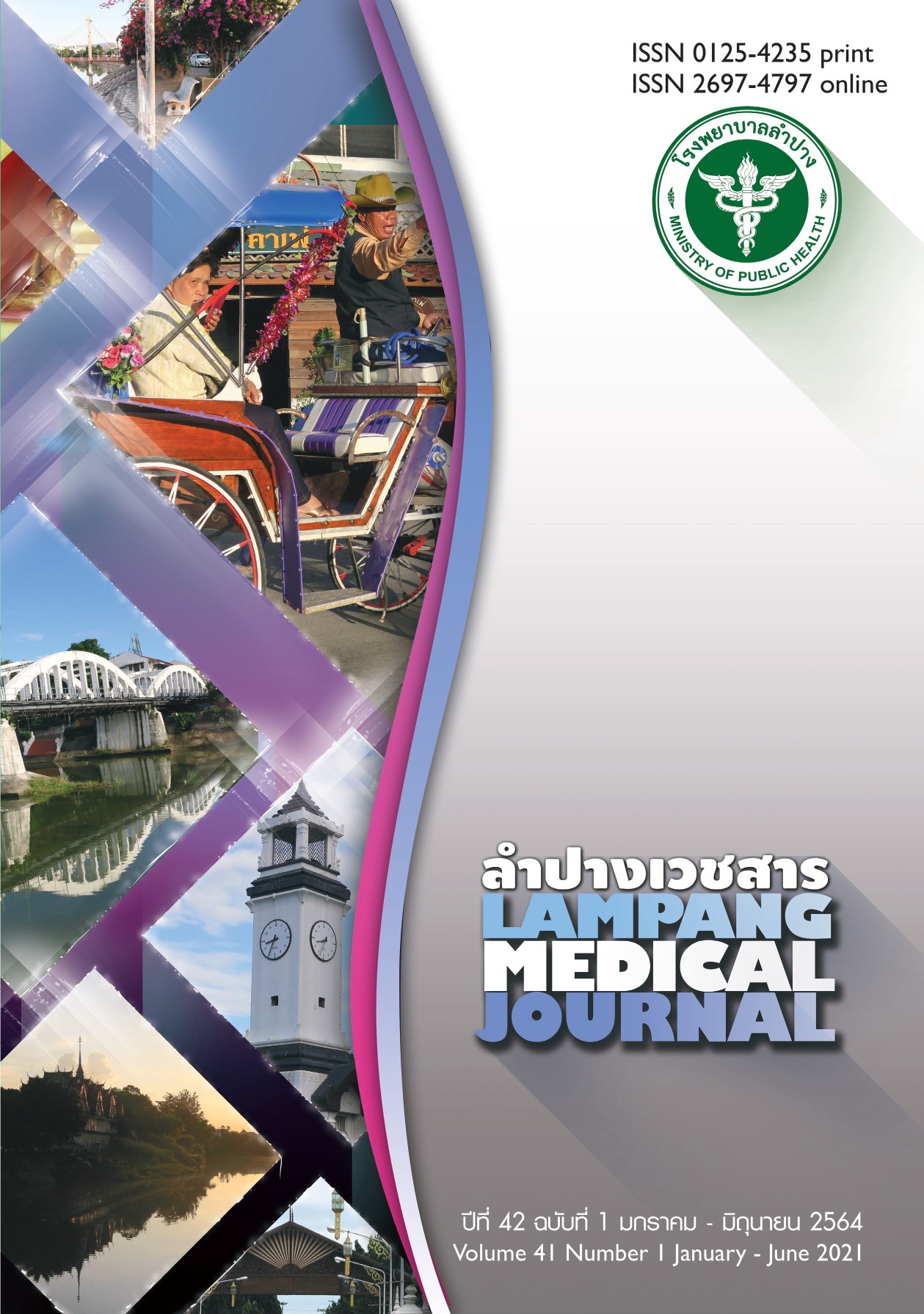Factors Related with the Firefighters’ Stresses whilt Wildfire Suppression at Doi Phrabat, Lampang Province
Main Article Content
Abstract
Background: Smog from the wildfire at Doi Phrabat causes air pollution in Mueang District, Lampang province every year. Wildfire suppression is tough, tired and dangerous, leading to stress of the firefighters.
Objective: To determine the level of stress and factors related with the firefighters’ stress levels whilst wildfire suppression at Doi Phrabat.
Materials and methods: A survey research was conducted among 240 firefighters using the stress assessment questionnaires (SPST-20) during wildfire suppression at 7–31 March 2019. Data were analyzed using descriptive statistics. Factors related with the level of stress were analyzed using Chi-square test.
Results: The mean age was 48.7 (SD 12.6) years (range, 15–72) and 73.8% was male. Two-thirds were local volunteer firefighters and 44.2% were full-time operators. Most of the firefighters (57.9%) were anxious with the haze situation, 40.4% had a high level of stress and 28.8% had moderate level. Factors related with the firefighters’ stress levels were having anxiety, extended working period, receiving the fire situation information, working related diseases and trauma (p=0.001), lacking of equipment (p=0.002), teamwork relationship (p=0.004) and lacking of mental support (p=0.013).
Conclusion: Having anxiety, extended working period, teamwork relationship, working related diseases and trauma, inadequate equipment and mental support were related with the firefighters’ stresses during wildfire suppression at Doi Phrabat.
Article Details
บทความที่ส่งมาลงพิมพ์ต้องไม่เคยพิมพ์หรือกำลังได้รับการพิจารณาตีพิมพ์ในวารสารอื่น เนื้อหาในบทความต้องเป็นผลงานของผู้นิพนธ์เอง ไม่ได้ลอกเลียนหรือตัดทอนจากบทความอื่น โดยไม่ได้รับอนุญาตหรือไม่ได้อ้างอิงอย่างเหมาะสม การแก้ไขหรือให้ข้อมูลเพิ่มเติมแก่กองบรรณาธิการ จะต้องเสร็จสิ้นเป็นที่เรียบร้อยก่อนจะได้รับพิจารณาตีพิมพ์ และบทความที่ตีพิมพ์แล้วเป็นสมบัติ ของลำปางเวชสาร
References
อัจฉรีย์ ทิพธนธรณินทร์. แนวทางการแก้ปัญหาหมอกควันสำหรับจังหวัดเชียงใหม่. วารสารด้านการบริหารรัฐกิจและการเมือง. 2558;4(1):73-105.
Aisbett B, Phillips M, Sargeant M, Gilbert B, Nichols D. Fighting with fire -- how bushfire suppression can impact on fire fighters’ health. Aust Fam Physician. 2007;36(12):994-7.
Aisbett B, Nichols D. Fighting fatigue whilst fighting bushfire: an overview of factors contributing to firefighter fatigue during bushfire suppression. Aust J Emerg Manag. 2007;22(3):31-9.
Armstrong DM. Investigating well-being and mental health in Queensland fire-fighters [dissertation]. Brisbane: Queensland University of Technology; 2014.
สุวัฒน์ มหัตนิรันดร์กุล, วนิดา พุ่มไพศาลชัย, พิมพ์มาศ ตาปัญญา. การสร้างแบบวัดความเครียดสวนปรุง. วารสารสวนปรุง. 2540;13(3):1-20.
Thromton RP, Wright LJ, editors. The stress of fire fighting: implications for long term health outcomes. Proceedings of Bushfire CRC & AFAC Conference Reseasrch Forum; 2012 Aug 28; Perth convention & exhibition center. Melbourne, Australia: Bushfire CRC; 2012.
Harvey SB, Milligan-Saville JS, Paterson HM, Harkness EL, Marsh AM, Dobson M, et al. The mental health of fire-fighters: An examination of the impact of repeated trauma exposure. Aust N J Psychiatry. 2016;50(7):649-58.
Bastug G, Ergul-Topcu A, Ozel-Kizil ET, Ergun OF. Secondary traumatization and related psychological outcomes in firefighters. J Loss Trauma. 2019;24(2):143-58.
Hytten K, Hasle A. Fire fighters: a study of stress and coping. Acta Psychiatr Scand Suppl. 1989;355:50-5.
Hwang J, Taylor R, Macy G, Cann CM, Golla V. Comparison of use, storage, and cleaning practices for personal protective equipment between career and volunteer firefighters in northwestern Kentucky in the United States. J Environ Health. 2019;82(5):8-14.
Dahlan A. Malek M, Mearns K, Flin R. Stress and psychological well‐being in UK and Malaysian fire fighters. Burke RJ, editor. Cross Cult Manag Int J. 2010;17(1):50–61.
Jahnke SA, Poston WSC, Haddock CK, Murphy B. Firefighting and mental health: experiences of repeated exposure to trauma. Work Read Mass. 2016;53(4):737-44.


